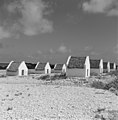GLAM/Newsletter/November 2016/Contents/Netherlands report
|
Temminck Groll Collection; WW2 underground newspaper project presented in Bonn; Stained glass in the picture
Temminck Groll Collection
In November 2016, the Temminck Groll Collection of the Dutch Rijksdienst voor het Cultureel Erfgoed, consisting of 2,641 historical photographs, was uploaded to Wikimedia Commons.
It’s a collection of photos of historical buildings and heritage in the following countries/regions:
- French Antilles
- French Guyana
- Ghana
- Guyana
- India
- Indonesia
- Malaysia
- Dutch Antilles
- Sri Lanka
- Suriname
- South Africa
These are all regions with which the Dutch have historical relations. The Dutch architect and architectural historian Coen Temminck Groll (1925-2015) shot these photos while travelling and studying 'shared cultural heritage' (heritage of the Netherlands located outside the country’s borders). These travels mainly took place in the 1960s and 1970s.
Temminck Groll worked on the subject of the shared cultural heritage of the Netherlands his entire life, and has widely published about it.
The collection is made available to Wikimedia Commons in the context of the project The Netherlands and the world.
All help is welcome in adding these images to Wikipedia articles, Wikidata items, monument lists and more!
-
Coen Temminck Groll
-
Anglican church, The Bottom, Saba
-
Road towards The Bottom, Saba
-
Fort St. Jago, Elmina, Ghana
-
Hotel in Colombo, Sri Lanka
-
Mosque in Cilincing, Java, Indonesia
-
Breedestraat 22, Willemstad, Curaçao
-
Ruin of synagogue, Oranjestad, St. Eustatius
-
Slave houses, Bonaire
-
Villa Isola, Bandung, Java, Indonesia
WW2 underground newspaper project presented during conference in Bonn
On 29th November Olaf Janssen, the GLAMwiki coordinator of the Dutch National Library , presented his project to describe all Dutch underground resistance newspapers from WW2 (page in Dutch) on Dutch Wikipedia. He did this during the Semantic Web in Libraries 2016 (SWIB 2016) conference, 28-30 November 2016, Bonn, Germany. His slidedeck is here.
Outline of talk: During the second World War some 1.300 illegal newspapers were issued by the Dutch resistance. Right after the war as many of these newspapers as possible were physically preserved by Dutch memory institutions. They were described in formal library catalogues that were digitized and brought online in the ‘90s. In 2010 the national collection of underground newspapers – some 200.000 pages – was full-text digitized in Delpher, the national aggregator for historical full-texts. Having created online metadata and full-texts for these publications, the third pillar context was still missing, making it hard for people to understand the historic background of the newspapers. We are currently running a project to tackle this contextual problem. We started by extracting contextual entries from a hard-copy standard work on Dutch illegal press and combined these with data from the library catalogue and Delpher into a central LOD triple store. We then created links between historically related newspapers and used Named Entity Recognition to find persons, organisations and places related to the newspapers. We further semantically enriched the data using DBPedia. Next, using an article template to ensure uniformity and consistency, we generated 1.300 Wikipedia article stubs from the database. Finally, we sought collaboration with the Dutch Wikipedia volunteer community to extend these stubs into full encyclopedic articles. In this way we can give every newspaper its own Wikipedia article, making these WW2 materials much more visible to the Dutch public, over 80% of whom uses Wikipedia. At the same time the triple store can serve as a source for alternative applications, like data visualizations. This will enable us to visualize connections and networks between underground newspapers, as they developed over time between 1940 and 1945.
Stained glass in the picture

User Ronn has completed a wonderful solo project. He’s a passionate writer on articles about Dutch sculpture. During the writing of these articles he regularly encountered artists who also designed stained glass. He discovered the book Glas in lood in Nederland 1817-1968, which is known as a standard in this field, with 147 biographies and information about the history of this craft. Thanks to a financial contribution of Wikimedia Nederland this rather expensive book could be purchased by him.
In 2013 there were about 370 photos uploaded to Wikimedia Commons that were made for the book. The photos were donated by the Dutch Cultural Heritage Agency (Rijksdienst voor Cultureel Erfgoed) and were categorized on church/building. Ronn has put them all in one category and has linked the maker with each window, and done this for or as many windows in the buildings categories as possible. With the creation of 90 new categories for artists and commemoration windows on Commons the findability has increased for these photo’s. For the Dutch Wikipedia Ronn wrote or substantially improved a little over 100 articles. New articles are for example (in Dutch) Atelier F. Nicolas en Zonen (1855), Femmy Schilt-Geesink, Wim van Woerkom, Gedenkramen in het Academiegebouw (Groningen) (1931-1957) and Een tuin van glas (2005).
For the project he corresponded with several GLAM institutions, including the Rijksmuseum. On the base of this correspondence the Rijksmuseum released an extra 7500 photo's under a free license.
Ronn spend a little more than one year completing this project. He calls it a solo project but, as he says himself, got help from many others. It goes to show that with the persistence of one person and help from others within the community a lot can be accomplished!
| Home | About | Archives | Subscribe | Suggestions | Newsroom |












